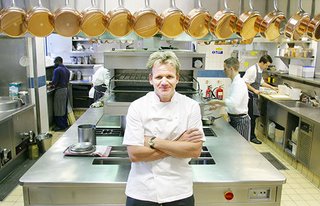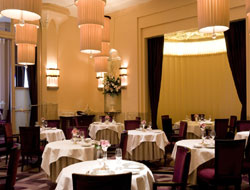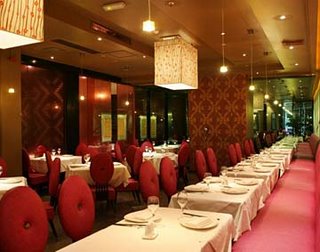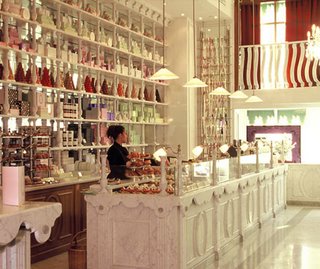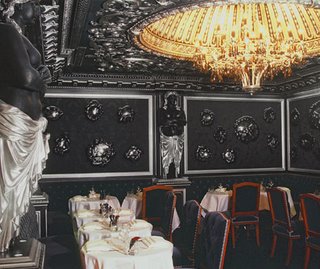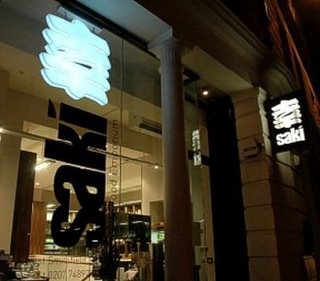 Saki calls itself a Food Emporium. Upstairs, you’ve got a little Japanese supermarket, all bonito flakes and kewpie doll mayonnaise. Downstairs there’s an elegant bar and a small, lacquered-box red and black restaurant.
Saki calls itself a Food Emporium. Upstairs, you’ve got a little Japanese supermarket, all bonito flakes and kewpie doll mayonnaise. Downstairs there’s an elegant bar and a small, lacquered-box red and black restaurant.
I have spent half an hour staring at a largely blank page, because I have a dilemma. Should I begin this post by telling you about the food or the toilets? I was charmed by both…but I’m going to start with the loos, because although they were probably slightly less fun than the magnificent food, they were a heck of a lot more fun than any other restaurant toilet I’ve ever used.
This is because Saki, being a self-respecting Japanese establishment, doesn’t have normal toilets. They have washlets (the Japanese high-tech loo with the retractable bidet washy stalk thing and the jets of hot air and the heated seat and the thing that squirts you in the bum with such astonishing precision that you come to the conclusion that there must be a camera in there for targeting purposes) in the bathrooms. Allow yourself longer than you expect you will need for your meal, because you’ll want to make a few lengthy trips to the lavatory to make sure you’ve tried out all the thing’s functions. And do not push the wash button if you are not sitting down.
Shame on all the men in our party, who refused to use the things, sticking (manfully?) to the urinals.
Enough on the toilets, anyway – we were here for the food, and decided that the best way to sample the best of what was on offer was to go for the omakase, or chef’s choice. Most good Japanese restaurants should offer an omakase meal, which will involve many courses including cooked dishes and sushi, all selected from whatever produce is best and freshest on the day.
Our meal opened with seared lobster sashimi with white asparagus and caviar in a sesame sauce. As usual, I had to ask for an alternative (eating lobster usually results in a hospital visit and adrenaline shot for me), and the chef very kindly substituted barely seared scallops for the lobster. The scallops and asparagus were achingly sweet, and the sesame sauce so rich and good that we all agreed we wished we had spoons to scrape the bowl with. I could have done with more caviar, but it was pointed out to me by Dr W that I could always do with more caviar, so this is not a helpful criticism.
Next up was a little nimono (simmered dish) of duck breast with young bamboo shoot (that’s the yellow thing in the picture), mooli and a fresh, plump and silky shitake mushroom. The duck here had been rolled in rice flour before simmering, which gave it a shadow of sticky coating, helpful in making sure the gorgeous broth stayed close to the moist meat. A surprising hit of wasabi (freshly grated) lurked between the two bottom bits of duck. I checked to make sure nobody was looking and drank the remaining broth from the bowl when I was done.
The chilled Hakkaisan Junmai Ginjo sake from Nigata served with this course was, for me, the best drink of the night. On the whole, sake pairings with this menu were much more successful than the wine pairings which came with certain courses – if you visit, you might want to consider asking for an all-sake pairing with your meal.
King prawn and nanohana flower tempura came next, with a black vinegar sauce. I believe nanohana is the same plant as oil-seed rape – I could be wrong here, though, and would be delighted to be enlightened by any Japanese-speaking readers!
Prepared in tempura style, the flowers were slightly peppery, and very delicate. Some puffed rice had been used in the batter for the prawns, working beautifully with this course’s sake accompaniment (this time a room-temperature brown rice sake from Hyogo).
The menu offered a choice for the next course: black cod with Saikyo miso or rib-eye teriyaki. I chose the cod (black cod, confusingly, is actually a kind of sea bass, and is very rich, so a small piece can make for a satisfying main dish) to see how it compared to the Nobu and Michael Mina versions. Charmingly, it arrived on a hoba (magnolia) leaf imported from Japan, and unlike the versions of this dish I’ve tried elsewhere, the grill had left almost no browning or caramelisation – the fish was barely, barely cooked, and sweet, flaking delicately to the touch. The table was in disagreement about the ribeye teriyaki – my Mum, whose birthday we were celebrating, found the sauce overpowering, but everyone else seemed to be licking it off their plates when they’d done. Teriyaki means ‘shining cooked’, and a good teriyaki sauce should be thick and glossy – personally, I liked the mouthful I tried a great deal.
Sushi. Buttery, melt-in-the mouth Toro (the pink tuna on the left – Toro is from the fish’s prized, fatty belly) was the best I’ve had in the UK. The white fish is yellowtail, which had been briefly marinaded in lemon and garlic – just enough to barely ‘cook’ its proteins and produce a kind of ceviche. The ebi (prawn) was sweet and juicy, and the uni (sea urchin – the black and orange confection on the right) was, again, absolutely the best I’ve found in the UK. It tasted as it should – sweetly iodine-y, sea-like and fresh, fresh, fresh. My sister-in-law, who has had bad experiences with uni, tried this and said it was great – and that uni this fresh was unlike any she’d had elsewhere. (Compare this picture with the awful, elderly uni I had a couple of years ago elsewhere in London, and you’ll see an amazing difference in colour and texture.)
The little chequerboard of tamago (sweetened egg) was good, but I was unconvinced by the vegetable maki at the top of the plate. These rolls were filled with cucumber, avocado, asparagus, carrot…and black onion seeds, which, for me, completely overwhelmed the other flavours in the roll, and made the well-seasoned rice an irrelevance, because you couldn’t taste it over the black onion. The freshly grated wasabi made up for that, though; you hardly ever find it fresh, especially in the UK, and it is an aromatic and sweet m
arvel when you do.
Finally, the dessert (with a birthday candle for Mum), made up of a tiramisu dredged with green tea powder, a fiori di latte ice, and a black sesame panna cotta (my favourite thing on the plate). It’s great to find a black sesame preparation this light – usually, the ground seeds find their way into richly oily desserts, but this panna cotta kept all of the flavour without leaving you feeling weighed down. A wine upset with this course – we were meant to be served a Coteaux du Layon, but what arrived appeared to be a dry sherry. We asked for a substitution…and glasses of something which appeared to be the Coteaux du Layon which we were meant to have had appeared without an explanation.
I’ll let them off. Their toilets are great.
This bounty does not come cheap. With a wine/sake pairing, the omakase menu is £90/head (£55/head if you are not taking the wine pairing). All the same, this is the best Japanese food I’ve found yet in London – or anywhere in the UK – and I liked it enough that I’ll happily go back and pay the same price all over again.

